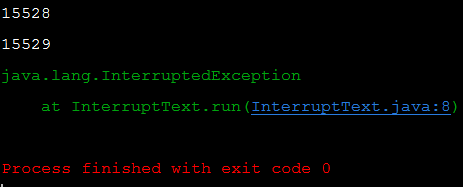一.停止线程会带来什么?
对于单线程中,停止单线程就是直接使用关键字return或者break,但是在停止多线程时是让线程在完成任务前去开启另外一条线程,必须放弃当前任务,而这个过程是不可预测,所以必须去做好防备。
二.认识停止线程的几个方法
2.1三个被弃用的方法
stop()、suspend()、resume()。
stop()方法被弃用的原因:无论线程执行到了什么位置,一旦被stop就会被马上强制中断,并且释放线程所有持有锁对象,根本就没有安全性。
suspend()和resume()这一对烂兄烂弟,因为只有其他线程调用resume这个方法时他才会释放suspend这个方法的锁,这样就极易造成死锁。
2.2三个名字差不多的方法
interrupt()中断线程、interrupted()判断当前线程是否停止、isInterrupted()判断线程是否停止。
首先来介绍一下其中两个名字最相近的:interrupted()、isInterrupted()方法,这两个方法是用来测试线程是否被中断的。
来看一下原码:
isInterrupted():
public boolean isInterrupted() { return isInterrupted(false); }
interrupted():
public static boolean interrupted() { return currentThread().isInterrupted(true); }
可以明显看出interrupted()方法是静态的,而isInterrupted()是非静态的,但都是返回线程是否被中断。
下面我们来做一个测试,代码如下:
public class Is_Interrupt extends Thread{ @Override public void run(){ for(int i=0;i<1000;i++){ System.out.println("当前i的值为:"+i); } } public static void main(String[] args) { Is_Interrupt is_interrupt=new Is_Interrupt(); is_interrupt.start(); is_interrupt.interrupt();//中断线程 System.out.println("线程是否已经暂停?"+is_interrupt.interrupted()); } }
输出结果为:
发现线程没有停止。
但是这里面还有一个线程就是main线程,而interrupted()返回的就是当前线程的中断状态,那么执行这个方法的就是main线程,而main线程此时当然没有中断。
我们将interrupted()方法改为isInterrupted()试试效果,代码如下:
public class Is_Interrupt extends Thread{ @Override public void run(){ for(int i=0;i<1000;i++){ System.out.println("当前i的值为:"+i); } } public static void main(String[] args) { Is_Interrupt is_interrupt=new Is_Interrupt(); is_interrupt.start(); is_interrupt.interrupt();//中断线程 System.out.println("线程是否已经暂停?"+is_interrupt.isInterrupted()); } }
结果如下:
说明线程是已经停止了的,只不过我们使用错了一个方法而已判断成了main线程的状态。
总结:isInterrupted方法是返回调用对象的中断状态,而静态方法interrupted是返回当前线程的中断状态。
既然了解了这个误区以后我们再来看看下面的代码:
public class InterruptText extends Thread{ public static void main(String[] args) { System.out.println("main线程启动!"); System.out.println( Thread.interrupted());//判断当前线程是否中断 System.out.println(currentThread().isInterrupted());//通过currentThread().isInterrupted()同样也可以达到相同的目的,在单线程中 } }
输出:
 这个是没有问题的。
这个是没有问题的。
那么我们多次调用这个interrupted方法呢?
public class InterruptText extends Thread{ public static void main(String[] args) { System.out.println("main线程启动!"); currentThread().interrupt();//中断main线程 System.out.println( Thread.interrupted());//判断当前main线程是否中断 System.out.println( Thread.interrupted());//再一次判断当main前线程是否中断 } }
结果: 按照常理应该两次返回ture,但是为什么变成了第二次变成了false了呢?
按照常理应该两次返回ture,但是为什么变成了第二次变成了false了呢?
其实interrupted就是在清除状态,你两次调用当然会将true变成flase但是他还是中断状态,但是isInterrupted是不清除的。
interrupt()方法:中断线程
三.停止线程
3.1通过异常来暂停线程
首先来看一段代码:
public class InterruptText extends Thread{ @Override public void run(){ try { for (int i = 0; i < 100000; i++) { if (currentThread().isInterrupted()) {//如果线程中断 throw new InterruptedException();//抛出异常 } else { System.out.println(i); } } System.out.println("线程没有终止"); }catch (InterruptedException e){ e.printStackTrace(); } } public static void main(String[] args) throws Exception { InterruptText interruptText=new InterruptText(); interruptText.start(); Thread.sleep(100); interruptText.interrupt(); } }
结果:
异常停止方法的策略就是:在遇到中断时,抛出异常,扑捉异常。
3.2在睡眠中中断线程
代码如下:
public class InterruptText2 extends Thread { @Override public void run(){ try { Thread.sleep(10000);//线程睡眠 } catch (InterruptedException e) { e.printStackTrace(); } } public static void main(String[] args) { InterruptText2 interruptText2=new InterruptText2(); interruptText2.start();//开启线程,但是线程处于睡眠状态 interruptText2.interrupt();//在睡眠状态中断线程 } }
结果为:
3.3线程让步
方法:yield(),当前线程放弃所有的资源,去执行其他的任务。但是放弃资源的时间不可以预判的。
3.4守护线程
守护线程的定义:守护线程是一种特殊的线程,区别于非守护线程,当程序中不存在非守护线程时,守护线程退出,程序退出。
设置守护线程:setDaemon(),参数为ture则该线程为守护线程。